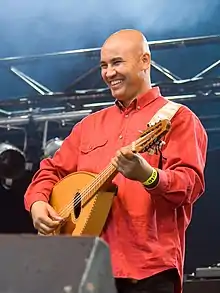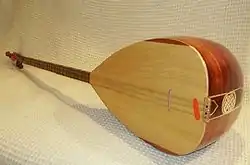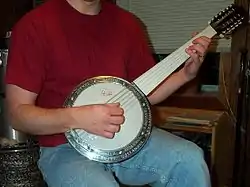Middle Eastern and North African music traditions
This is a list of folk music traditions, with styles, dances, instruments, and other related topics. The term folk music cannot be easily defined in a precise manner. It is used with widely varying definitions depending on the author, intended audience and context within a work. Similarly, the term traditions in this context does not connote any strictly-defined criteria. Music scholars, journalists, audiences, record industry individuals, politicians, nationalists, and demagogues may often have occasion to address which fields of folk music are distinct traditions based along racial, geographic, linguistic, religious, tribal, or ethnic lines, and all such peoples will likely use different criteria to decide what constitutes a "folk music tradition". This list uses the same general categories used by mainstream, primarily English-language, scholarly sources, as determined by relevant statements of fact and the internal structure of works.
| Lists of folk music traditions |
|---|
These traditions may coincide entirely, partially or not at all with geographic, political, linguistic, or cultural boundaries. Very few, if any, music scholars would claim that there are any folk music traditions that can be considered specific to a distinct group of people and with characteristics undiluted by contact with the music of other peoples; thus, the folk music traditions described herein overlap in varying degrees with each other.
Middle East and North Africa

 A Turkish mandolin-banjo
A Turkish mandolin-banjo A Turkish baglama
A Turkish baglama A Turkish cümbüş
A Turkish cümbüş
| Country | Elements | Dance | Instrumentation | Other topics |
|---|---|---|---|---|
| Armenian | kef – folk – liturgical – Tashnakzootyoun | tamzara – kochari – religious | duduk – oud – dumbeg – saz – bouzouki – shvi | |
| Algerian[1] | medh – melhun – raï – zendani | gasha – guellal | berrah – cheikha – meddhahates – mehna – wa'adat | |
| Assyrian | diwaneh – liliana – raweh | baglama – Çiftelia – davul – dhol – dutar – tambura – zurna – saz – watariyat | ||
| Bahraini | See Persian Gulf region | – | – | – |
| Bedouin[2] | zajal | fantasia | mijwis – mismar – yaghul | |
| Berber[3] | amarg – ammussu – astara – ritual music – tabbayt | aberdag – ahidu – ahouach – ahwash | ajouag – bendir – ghaita – lotar (instrument) – nakous – ney – rabab – t'bel – tinde – viol | amydaz – imdyazn – laamt – rwai |
| Chleuh | See Berber | – | – | – |
| Coptic | See Egyptian | – | – | – |
| Djiboutian | balwo | bowl lyre – tanbura | ||
| Egyptian[4] | Saiyidi – sawahili – wedding music | awalim | mismar saiyidi – nahrasan | |
| Emirati | See Persian Gulf region | – | – | – |
| Eritrean | folk – liturgical – popular | kebero – kobar – kraar – lyre – wata | ||
| Ethiopian | folk – liturgical – popular | begena – kebero – kraar – masenqo – sistrum – washint | ||
| Georgian[5] | Georgian polyphony – krimanchuli – naduri – orovela – table song | accordion – changui – chonguri – chuniri – clarinet – duduk – panduri | ||
| Iranian[6] | daf – dohol – karnay – lute – ney – ney-anban – zurna | |||
| Israeli and diaspora Jewish | Klezmer – Sephardic music – Mizrahi music – Secular Jewish music | Israeli folk dancing – Horah – | lutes – oud | |
| Kabyle | See Berber | – | – | – |
| Khaleeji | See Persian Gulf region | – | – | – |
| Kuwaiti | See Persian Gulf region | – | – | – |
| Kurdish[7] | epic | Bloor – daf – dhol – doozela – duduk – kamanche – ney – oud – santur – shimshal – tabalak – tar – tenbur – zil – zurna | chirokbej – dengbêj – stranbej | |
| Persian Gulf region[8] | Khaleeji music – sawt (music)-tarab-Adani-shela | Ardha, dabkah | duff – teeran – nay – oud – rababa – merwass – tabla – binges – qanun | |
| Lebanese[9] | dabkah | |||
| Mauritanian | al-bayda – epic – fagu – l'-gnaydiya – al-kahla – karr – labyad – lakhal – lebtayt | dabkah | ardin – daghumma – tbal – tidinit | iggawin[10] |
| Moroccan[11] | takht | ait atta – ait Bodar – ait Bugemaz (ait bouguemaz) – taskiwin | aghanin – bendir – darbuka – duff – garagab – ghaita – gimbri – guedra – kamanjeh – kanum – nai – nakous – oud – rabab – taarija – tabl – tan-tan – tar | moussem |
| Nubian[12] | duff | |||
| Omani | See Persian Gulf region | – | – | – |
| Palestinian[13] | dalauna – meyjana – Zaghareet – wedding music- Ataaba – Sahja – zajal | dabka | duff – mijwiz – nay – oud – rababa – shababi – tabla – yarghoul-oud-qanun | zajaleen |
| Pashtun[14] | Afghan wedding music – kiliwali | chub bazi – atan | daireh – dhol – rubab – tanbur | landai |
| Persian | See Iranian | – | – | – |
| Qatari | See Persian Gulf region | – | – | – |
| Saudi Arabia | Qasida | Ardah – Mizmar – Daha | Oud – Rebab – Tar – Ney – Mizmar | {{{Other}}} |
| Arabic, Islamic, Jewish music[15] | cantica – copla – endechas – romance – Songs for Purim – wedding music | accordion – darabouka – kanun – oud – tambourine | ||
| Somali | balwo, qaraami, dhaanto | batar drum – oud | ||
| Sudanese Arab[16] | haqiiba | oud – tambour | ||
| Tuareg | See Berber | – | – | – |
| Turkish[17] | bozlak – türkü | çifte telli – halay – horon – karsilama – köçek oyunu – semah – sword dance – zeybek | darbuka – davul – kemence – ney – saz – sipsi – Tulum (bagpipe) – zurna | ashik – chengi – düg¨nsalonu – köçekce |
| Yemeni[8] | oud | ghat |
Notes
- Morgan, Andy, "Music Under Fire" in the Rough Guide to World Music, pgs. 413 – 424
- Lodge, David and Bill Badley, and Badley, Bill and Zein al Jundi, "Cairo Hit Factory" and "Europe Meets Asia in the Rough Guide to World Music, pgs. 338 – 346 and pgs. 391 – 395; Kinney, pgs. 207 – 208
- Includes the music of Kabylie and the Tuareg; Morgan, Andy, François Bensignor, and Dave Muddyman, "Bards of Immigritude", "Sounds of the Sahel" and "A Basic Expression of Life" in the Rough Guide to World Music, pgs. 425 – 426, pgs. 585 – 587 and pgs. 567 – 578; World Music Central Archived 2006-02-07 at the Wayback Machine
- Lodge, David and Bill Badley, "Cairo Hit Factory" in the Rough Guide to World Music, pgs. 338 – 346; World Music Central Archived 2006-02-07 at the Wayback Machine
- Broughton, Simon, "A Feast of Songs" in the Rough Guide to World Music, pgs. 347 – 350
- Nooshin, Laudan, "The Art of Ornament" in the Rough Guide to World Music, pgs. 356 – 362
- Nooshin, Laudan, and Eva Skalla and Jemima Amiri, "The Art of Ornament" and "Songs of the Stateless" in the Rough Guide to World Music, pgs. 356 – 362 and 378 – 384
- Badley, Bill, "Sounds of the Arabian Peninsula" in the Rough Guide to World Music, pgs. 351 – 354
- Manuel, Popular Musics, pg. 159
- Muddyman, David and Richard Trillo, "The Ways of the Moors" in the Rough Guide to World Music, pgs. 563 – 566
- Muddyman, Dave, "A Basic Expression of Life" in the Rough Guide to World Music, pgs. 567 – 578; ; World Music Central Archived 2006-02-07 at the Wayback Machine
- Lodge, David and Bill Badley, "Cairo Hit Factory" in the Rough Guide to World Music, pgs. 338 – 346
- Morgan, Andy and Mu'tasem Adilah, "The Sounds of Struggle" in the Rough Guide to World Music, pgs. 385 – 390
- Manuel, Popular Musics, pg. 196; Doubleday, Veronica, "Red Light at the Crossroads" in the Rough Guide to World Music, pgs. 3 – 7
- Cohen, Judith, "Ladino Romance" in the Rough Guide to World Music, pgs. 370 – 377
- Verney, Peter with Helen Jerome and Moawia Yassin, "Yearning to Dance" in the Rough Guide to World Music, pgs. 672 – 680
- Stokes, Martin, "Sounds of Anatolia" in the Rough Guide to World Music, pg. 396 – 410; Kinney, pgs. 216 – 217; World Music Central Archived 2006-02-07 at the Wayback Machine
References
- Broughton, Simon (2000). Mark Ellingham (ed.). Rough Guide to World Music (First ed.). London: Rough Guides. ISBN 1-85828-636-0.
- Karolyi, Otto (1998). Traditional African & Oriental Music. Penguin Books. ISBN 0-14-023107-2.
- Kinney, Troy and Margaret West (1935). The Dance: Its Place in Art and Life. Tudor Publishing.
- Manuel, Peter (1988). Popular Musics of the Non-Western World. New York: Oxford University Press. ISBN 0-19-505342-7.
- Philip V. Bohlman; Bruno Nettl; Charles Capwell; Thomas Turino; Isabel K. F. Wong (1997). Excursions in World Music (Second ed.). Prentice Hall. ISBN 0-13-230632-8.
- Fujie, Linda; James T. Koetting; David P. McAllester; David B. Reck; John M. Schechter; Mark Slobin; R. Anderson Sutton (1992). Jeff Todd Titan (ed.). Worlds of Music: An Introduction to the Music of the World's Peoples (Second ed.). New York: Schirmer Books. ISBN 0-02-872602-2.
- "International Dance Glossary". World Music Central. Archived from the original on February 7, 2006. Retrieved April 3, 2006.